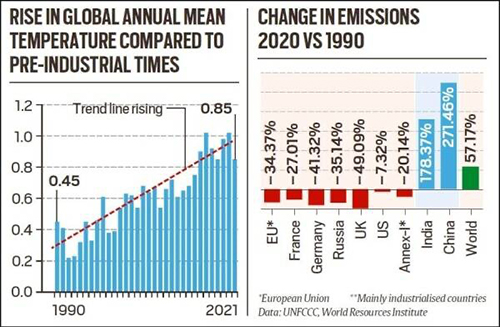Date: 04/11/2022
Relevance: GS-3 : Environmental pollution and degradation.
Key Phrases: COP 26, COP 27, UNFCCC, Nationally Determined Contributions or NDCs, Panchamrit Strategy, Climate Change, Net Zero
Why in News?
- The annual United Nations Climate Change Conference (COP27) is scheduled to be held at Sharm El Sheikh in Egypt on November 6-18.
Key Highlights
- The 26th UN Climate Change Conference of the Parties (COP26) was held in Glasgow, UK.
- The aim was to finalise the rules and procedures for implementation of the Paris Agreement and to get all countries to commit to a net-zero target by a specific year.
- More than 400 financial institutions overseeing $130 trillion in assets promised to align their portfolios with the target of achieving carbon neutrality by 2050.
A Status Check
- Latest assessments suggest that current action plans of countries to meet climate goals are falling woefully short.
- Rising Emissions
- The annual global emissions are still rising, now touching almost 50 billion tonnes of carbon dioxide equivalent.
- In the decade between 2010 and 2019, the global emissions grew by over one per cent on an average.
- Recent data suggest that the annual mean temperature of the world is already higher by more than one degree Celsius from pre-industrial times.
- Current global emissions are more than 50 per cent higher than in 1990.
- Inadequate Response
- The rich and industrialised countries, which were the main polluters and hence mainly responsible to bring down emissions, have not met their collective targets.
- Developing countries like China or India, which were not major emitters till sometime back, have seen their emissions rise steeply.
- China’s emissions have risen by almost four times, and India’s by about three times, during this period.
- World Headed to 2.8-Degree Warming
- The overall climate objective is to ensure that the rise in global temperatures does not go beyond 2 degrees compared with pre-industrial times.
- Preferably, it needs to be restricted within 1.5 degree Celsius.
- Latest assessments suggest that if climate action is not immediately scaled up, the world is likely to become warmer by about 2.8 degree Celsius by the end of the century.
- Impact of Ukraine War
- The energy and economic crisis caused by the Ukraine war is threatening to undo even the small gains made.
- Already, the consumption of fossil fuels has gone up.
- Countries have begun to secure more and more traditional fossil fuels to deal with the uncertainty in the energy markets.
Progress Towards Achieving COP 26 Goals
- National emissions plans
- Nearly 200 countries agreed at last year’s COP26 summit to improve their emissions-cutting pledges, called Nationally Determined Contributions or NDCs.
- Only two dozen countries have achieved the target.
- Deforestation
- More than 100 countries pledged last year to end deforestation by 2030.
- Supporters included Brazil, Indonesia and Congo, which together contain more than 80% of the world’s remaining tropical forests.
- To achieve that goal, the area deforested would need to shrink by 10% each year from the 2020 cover but deforestation fell last year by just 6.3%.
- Methane pledge
- To date, 119 countries and blocs including the United States and the European Union have joined the COP26 pledge to slash methane emissions 30% from 2020 levels by 2030.
- But only 15 of them have come up with concrete plans to do so.
- Funding
- Rich countries’ failure to deliver promised finance to poorer nations has eroded trust at recent climate talks and made collective progress harder.
- Rich countries fell $16.7 billion short of the target in 2020 and have signalled that it won’t be met until 2023.
India’s Commitment and Progress
- Commitments
- India unveiled its panchamrit strategy at CoP26.

- Progress
- The first two - getting to 500 GW or thereabouts of renewable capacity and meeting about half our energy needs from renewables - appear on track.
- India is adding new renewable capacity at a faster clip than any other major economy, including China.
- India is already meeting 25 per cent of energy requirements from renewables (including hydro).
- Challenges
- One of the key, reasons behind India’s climate success is the underperformance of its manufacturing sector.
- Sluggish growth in the industrial sector has led to moderate
increase in industrial power demand and emission-intensity of GDP
- Industries comprise approximately one-fourth of the economy’s total GHG emissions.
- If manufacturing rebounds, that will worsen the problem.
- India has plans to double steel production to about 300 million tonnes per year and ramp up cement production to meet the needs of its ambitious infrastructure development plans.
- The air-conditioning sector is expected to sell nearly 10 million units this fiscal, compared to just six million two years ago.
- To reach net zero emissions by 2070, the IEA estimates that
$160 billion per year is needed, on average, across India’s
energy economy between now and 2030.
- That’s three times today’s investment levels.
Conclusion
- Though there would be usual calls for the need to urgently scale up climate action, the Sharm el-Shaikh meeting is unlikely to deliver anything concrete.
- Many countries, including India, had increased their climate pledges at the Glasgow meeting last year, and it would be unrealistic to expect them to do more this time.
- Occurrence of frequent climate disasters — like the historic flooding in Pakistan — is expected to result in renewed demands for a loss and damage framework, through which affected countries can seek compensation for the damages caused by extreme events.
Source: The Hindu BL, Indian Express
Mains Question:
Q. Current action plans of countries to meet climate goals are falling woefully short. Analyse. (250 Words).







